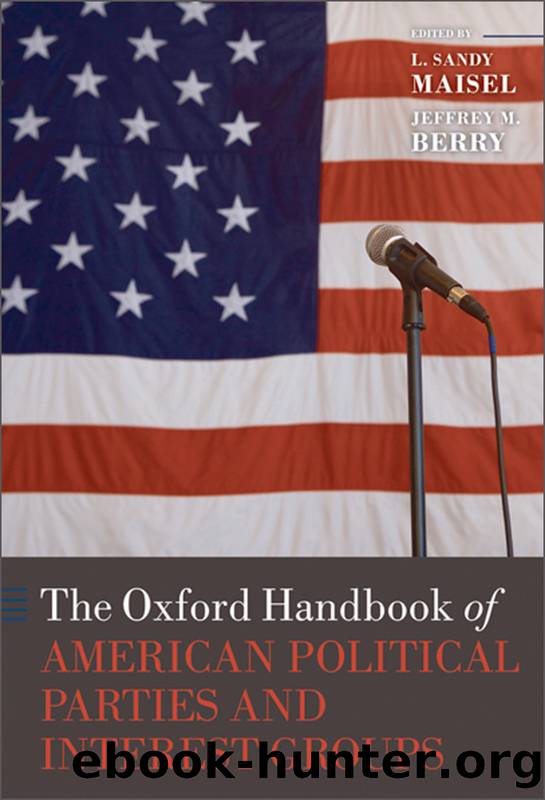The Oxford Handbook of American Political Parties and Interest Groups by Maisel L. Sandy;Berry Jeffrey M.;Edwards George C.;

Author:Maisel, L. Sandy;Berry, Jeffrey M.;Edwards, George C.;
Language: eng
Format: epub
Publisher: Oxford University Press, Incorporated
Published: 2011-06-15T00:00:00+00:00
INTRAPARTY AND INTERPARTY COALITIONS
IN THE FUTURE
The decline of bipartisan voting coalitions over time does not mean that bipartisanship has disappeared; rather, it means that it has taken on new forms. First, as Francis Lee clearly shows, divisive roll calls have become more prominent over time (Lee 2008, 242). These ideological cleavages persist over time and are often brought up so as to show the parties as clear alternatives to each other. This is consistent with what Cox and McCubbins (1993) mean by party brands, i.e., the issues that distinguish one party from the other. The rise in the number of roll call votes featuring these brand issues automatically decreases the number of votes where bipartisanship is present.
There are, of course, other issues before Congress that are largely distributive in nature (Lee 2008). If we look at procedural and brand issues, it is the case that bipartisanship is not present. However, if we look at areas such as transportation and agriculture, we see significant bipartisan voting behavior (Brady, Ferejohn, and Harbridge 2008) on these geographic and distributional issues. Further proof of this point is given by looking beyond the Poole, Rosenthal, and/or Americans for Democratic Action scores, which are polarized by party. If we turn to look at voting scores such as those produced by the National Taxpayersâ Union (NTU), the National Farmersâ Union (NFU), the AFLâCIO Committee on Political Education (COPE), and the League of Conservation Voters (LCV), we find on NTU, COPE, and LCV concerns, which are brand issues, voting overlaps between parties have declined from the 1960s. Cross-partisan voting on the NFU issues shows no trend over time and frequently measures 50 percent overlap (Harbridge 2009). Thus, bipartisanship still exists in some areas for fairly obvious constituent-driven reasons. We as a profession should be clear what we mean by partisanship and polarization and recognize where cross-partisanship works and where it does not. Ultimately, I believe that the origins of coalitions lie in constituent preferences and that some distributions of party over preferences yield intraparty coalitions while other distributions yield interparty coalitions.
Partial proof for the assertion that coalitional possibilities reside in the electoral connection lies in the findings of Harbridge (2009). Over the 1973 to 2006 time period, safe seats in the Congress increased 50 percent, while bipartisan co-sponsorship of legislation declined at a similar rate. That is, members from competitive seats are far more likely to co-sponsor legislation with members of the other party than are members from safe seats. Members from districts where the parties are evenly divided have all but disappeared in the House. However, members from such districts, e.g., Lupinski (Democrat, Illinois), will vote differently (present on the stimulus package in 2009), sponsor more bipartisan legislation, and, in general, do what is necessary in a mixed district to be reelected. Other scholars have shown that district characteristics determine intra- and interparty coalitions (Kanthak and Crisp 2005). Here it is interesting to note that because senators represent more heterogeneous constituencies than the House, they continue to be the main source of bipartisan behavior.
Download
This site does not store any files on its server. We only index and link to content provided by other sites. Please contact the content providers to delete copyright contents if any and email us, we'll remove relevant links or contents immediately.
The European History Highway: A Guide to Internet Resources by Dennis A. Trinkle Scott A. Merriman(498)
The Seven Wonders of the Ancient World by Michael Denis Higgins(480)
European Security in a Global Context by Thierry Tardy(472)
European Security without the Soviet Union by Stuart Croft Phil Williams(472)
The Routledge companion to Christian ethics by D. Stephen Long Rebekah L. Miles(461)
Hudud Al-'Alam 'The Regions of the World' - a Persian Geography 372 A.H. (982 AD) by V. V. Minorsky & C. E. Bosworth(402)
Get Real with Storytime by Julie Dietzel-Glair & Marianne Crandall Follis(393)
Gorbachev And His Generals by William C. Green(393)
Tibetan Studies in Comparative Perspective by Chih-yu Shih Yu-Wen Chen(387)
Governance, Growth and Global Leadership by Espen Moe(385)
Hyperculture by Byung-Chul Han(382)
CliffsNotes on Fitzgerald's The Great Gatsby by Kate Maurer(363)
The Oxford History of the World by Fernández-Armesto Felipe;(357)
How Languages Are Learned 5th Edition by Patsy M Lightbown;Nina Spada; & Nina Spada(356)
The Egyptian Economy, 1952-2000 by Khalid Ikram(355)
Oral Poetry and Narratives from Central Arabia: The Poetry of Ad-Dindan : A Bedouin Bard in Southern Najd (Studies in Arabic Literature, Vol 17) (English and Arabic Edition) by P. M. Kupershoek P. Marcel Kurpershoek(345)
The Oxford Handbook of the Incas by Sonia Alconini(336)
Europe Contested by Harold James(323)
The Hutchinson Dictionary of Ancient and Medieval Warfare by Peter Connolly John Gillingham John Lazenby(308)
